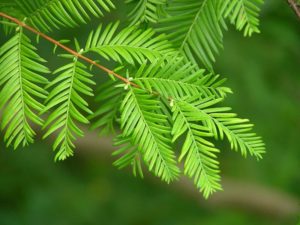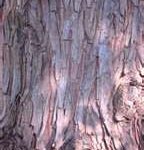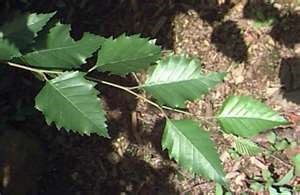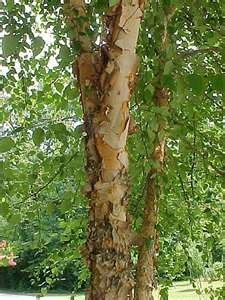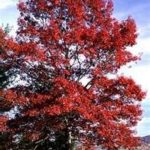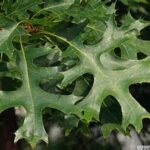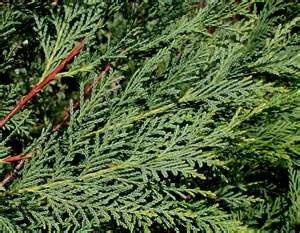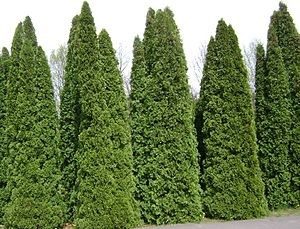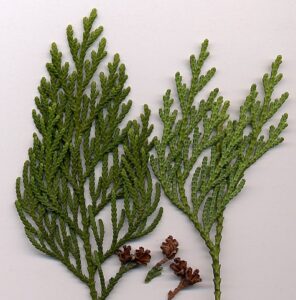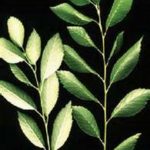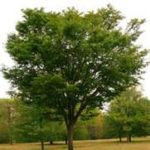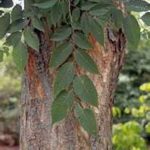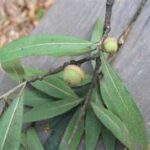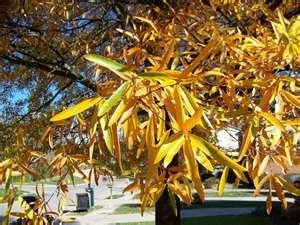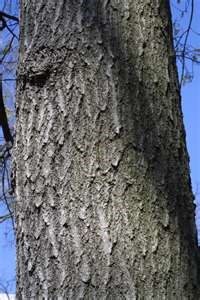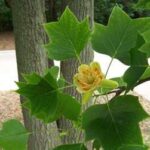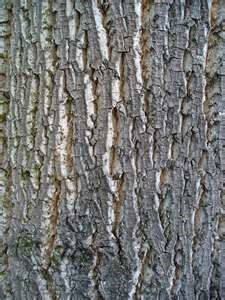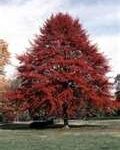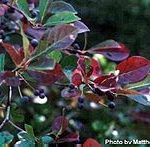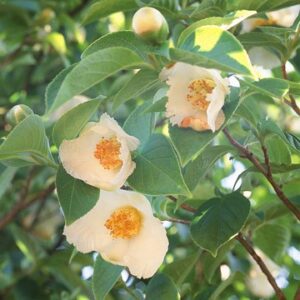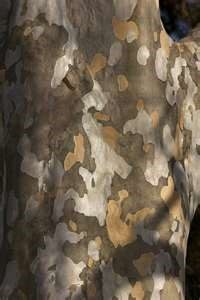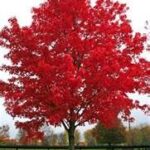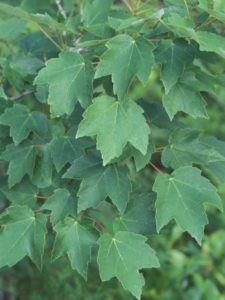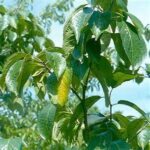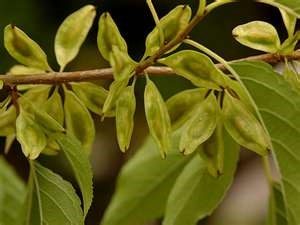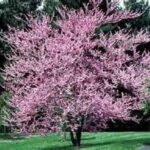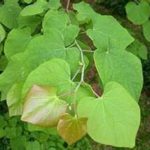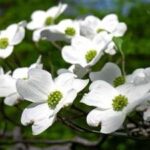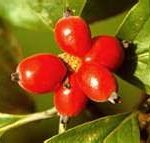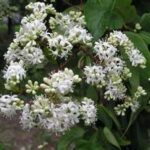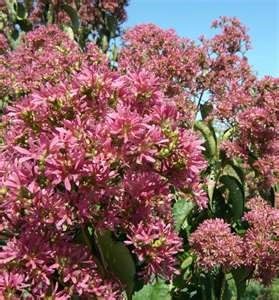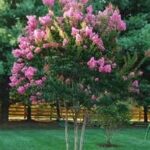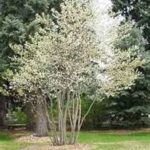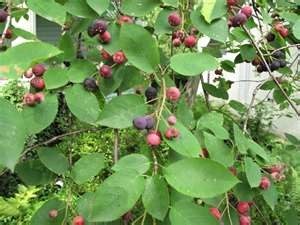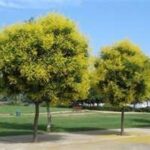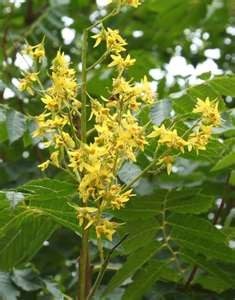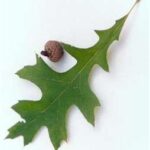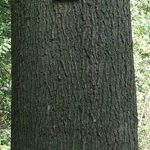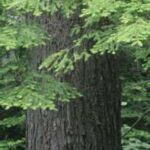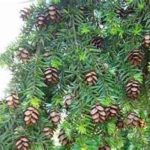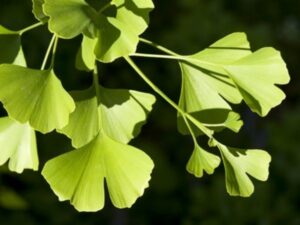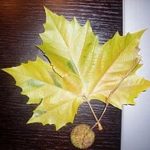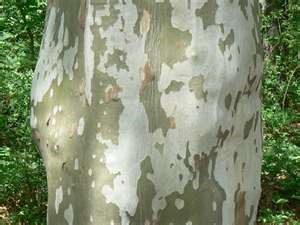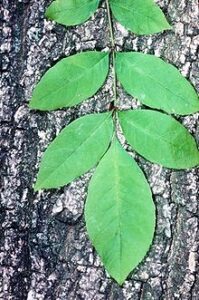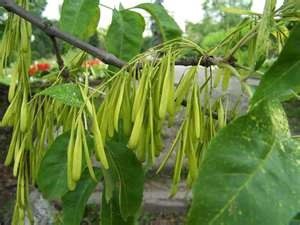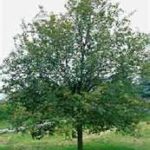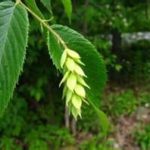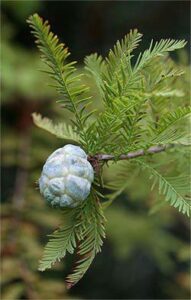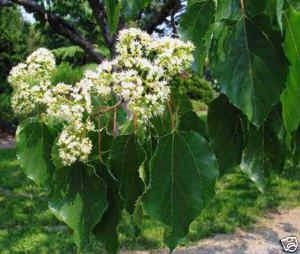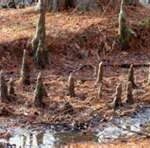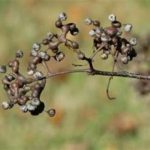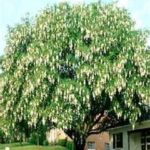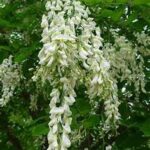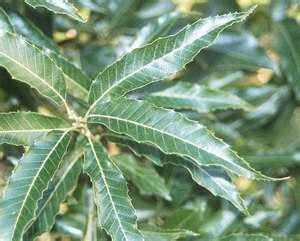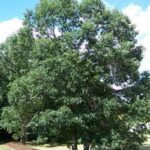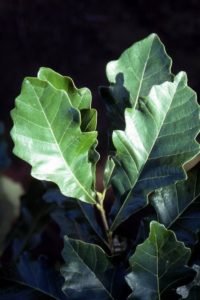The tree identification plaques are a result of a local Eagle Scout project by Grover Brown from Troop 10 working in conjunction with the City Urban Forester and the Greenway Board. There are 31 species of trees identified and marked with the common name, botanical name, and detailed information regarding each tree. A QR code on each plaque links you to this website. Each species identified below has a kmz file which allows you to geo locate the tree along the Greenway through Google Earth. Grover Brown and the Greenway Board are in the process of applying for the Greenway to become a Level 1 Arboretum.
1.Dawn Redwood
Metasequoia glyptostroboides
Dawn Redwood is a fast-growing, pyramidal shaped tree reaching a mature height of 70 to 100 feet with a 25 foot spread. Dawn Redwood grows best in full sun with a moist, well-drained soil and does not do well if grown in alkaline or dry soils and has the potential trunk diameter of 60 inches. Dawn Redwood has opposite needles that are approximately ½ inch long and turn shades of reds, oranges, and browns in the fall. The fruit is a 1″ cone, making this one of the few deciduous conifers. It was thought to have gone extinct about 20 million years ago, but was found growing in Central China in 1944. Well adapted to many areas, it is often confused with Bald Cypress (Taxodium distichum). The needles on Dawn Redwood are opposite, meaning directly across from each other, while Bald Cypress is alternate or staggered.
2.River Birch
Betula nigra
River Birch, also occasionally called Water Birch, is a species of Birch native to the eastern United States from New Hampshire west to southern Minnesota, and south to northern Florida and east Texas. It is commonly found in flood plains and/or swamps. It is a deciduous tree growing to 80 feet high with a trunk up to 2 feet diameter, often with multiple trunks. The bark is variable, usually dark gray-brown to pinkish-brown and scaly, but in some individuals, smooth and creamy pinkish-white, peeling in curly papery sheets. The twigs are thinly hairy, and odorless when scraped. The leaves are alternate, egg-shaped, 11/2 – 3 inches long and 1- 21/2 inches wide; with a saw-toothed margin. The fruit is a small nutlet maturing in late spring. While its native habitat is wet ground, it will grow on higher land, and its distinctive bark makes it a favored ornamental tree for landscape use. Native Americans used the boiled sap as a sweetener similar to maple syrup, and the inner bark as a survival food.
3.Scarlet Oak
Quercus coccinea
Scarlet Oak, also called Black Oak, Red Oak, or Spanish Oak, is native from southwestern Maine west to New York, Ohio, southern Michigan, and Indiana; south to southern Illinois, southeastern Missouri, and central Mississippi; east to southern Alabama and southwestern Georgia. It can grow up to 80 feet tall with a 36 inch diameter trunk, in dry, sandy, usually acidic soils. Its leaves are thin, smooth, shining above, paler beneath, sometimes hairy tufted on veins, 3 to 6 inches long, 2 to 5 inches broad, with 5 to 7 spreading bristly pointed and subdivided lobes. The sinuses between lobes are “C”-shaped and the acorns are half covered by a deep cap. The common English name is derived from the autumn coloration of the foliage, which generally becomes a brilliant scarlet. Scarlet oak is often planted as an ornamental tree, popular for its bright red fall color. The wood is generally marketed as red oak, but is of inferior quality, being somewhat weaker and not forming as large a tree.
4.Leyland cypress
Cupressus leylandii
Leyland Cypress is a hybrid created by crossing the Monterey cypress, Cupressus macrocarpa, and the Alaskan cypress, Cupressus nootkatensis. The Leyland Cypress, traditionally used as a Christmas tree, originated in England in 1888, from C.J. Leyland, who grew some of the first hybrids on his land. The Leyland Cypress has a tendency to grow very rapidly, about 3 to 4 feet a year, are able to grow to around 60 to 70 feet tall, but are capable of reaching heights of 70 to 100 feet with a width of approximately 12 to 20 feet. Leyland Cypress form a pyramid shape with flat branches of a green or blue green color. Leyland Cypress thrives in moist “well-drained” soil and is able to grow in dry landscapes with supplemental watering. The foliage color common to the Leyland Cypress are gray to bright green. Leyland Cypresses trees are usually planted in gardens and make a good screen or border of a property without using a fence.
5.Eastern Arborvitae
Thuja occidentalis
Eastern Arborvitae, other names include: American Arborvitae, Yellow Cedar, Arbor Vitae, Atlantic White Cedar, Northern White Cedar, Eastern White Cedar, False White Cedar, is an evergreen tree with fan-like branches and scaly leaves. Eastern Arborvitae is native to Manitoba east throughout the Great Lakes Region and into Québec, Vermont, New Hampshire, Maine, Prince Edward Island, New Brunswick, and Nova Scotia. Isolated populations exist to the south in Massachusetts, Connecticut, Ohio, Kentucky, Tennessee, North Carolina, Pennsylvania, Maryland, Virginia, and West Virginia. Growing to a height of 30–65 feet tall with a 2 foot trunk diameter. The bark is red-brown, furrowed and peels in narrow, longitudinal strips. The foliage forms in flat sprays with scale-like leaves 1/4 to 1/2 inch long with slender cones, yellow-green ripening brown, ¼ to ¾ inch long and inches broad, with 6-8 overlapping scales. Eastern Arborvitae is widely used as an ornamental tree, particularly for screens and hedges. The branches may take root if they come into contact with soil.
6.Bosque Elm
Ulmus parvifolia ‘UPMTF ’
Bosque® Elm, a cultivar of the Chinese Elm, is a fast growing deciduous tree with a single central leader and strong ascending branches forming a pyramidal crown. Bosque Elm can grow to a mature height of 60-65 feet tall and a 30-35 feet spread. The leaves are small, 1-2 inch long, lustrous dark green, turning yellow to orange in the fall. The trunk has handsome, flaking bark of mottled greys with tans and reds. It is a tough landscape tree, hardy enough for use in harsh planting situations such as parking lots, in small planters along streets and in plazas or patios.
7.Japanese Zelkova
Kelkova serrata
Japanese Zelkova is a medium sized deciduous tree, native to Japan, Korea, eastern China, and Taiwan, usually growing to 55 feet tall and with an upright and erect spreading stems forming a broad, round topped head. The tree grows rapidly when young though the growth rate slows to medium upon middle age and maturity. The leaves are oval shaped, with saw-toothed margins, alternately arranged, 1-2 inches long and up to 2 inches wide. They are green to dark green in spring and throughout the summer, and change to various assortments of yellows, oranges and reds. The bark is grayish white to grayish brown and either smooth or exfoliating in patches to reveal orange inner bark. It requires full to partial sun and prefers moist, well drained soils, but is adaptable and tolerant of heat, little water, nutrient poor soils and various ph. It is planted as a lawn or park tree for its attractive bark, leaf color and vase shape. It provides good shade and has an easy fall cleanup.
8.Willow Oak
Quercus phellos
Willow Oak, also known as Peach Oak, Pin Oak, and Swamp Chestnut Oak, is found mainly in bottom lands of the Coastal Plain from New Jersey and southeastern Pennsylvania south to Georgia and northern Florida; west to eastern Texas; and north in the Mississippi Valley to southeastern Oklahoma, Arkansas, southeastern Missouri, southern Illinois, southern Kentucky, and western Tennessee. It is a medium to large oak, 80 to 120 feet tall and up to 40 inches in diameter, known for its rapid growth and long life. Its willow like foliage is light to bright green in summer and yellow, yellow-brown and russet in fall. Since it produces an acorn crop almost every year it is an important food source for game animals such as ducks, squirrels, deer, and turkey. Blue jays and Red-headed Woodpeckers are major consumers, with White Grackles, Flickers, Mice, and Flying Squirrels utilizing the tree itself. Willow Oak is a favored shade tree and is widely planted as an ornamental.
9.Northern Red Oak
Quercus rubra
Northern Red Oak is native to the northeastern United States and southeast Canada, growing from the north end of the Great Lakes, east to Nova Scotia, south to Georgia. Often simply called “Red Oak”, Northern Red Oak is formally so named to distinguish it from Southern Red Oak, Quercus falcata. It grows rapidly and prefers well-drained borders of streams although it tolerates many soils and varied situations. In the wild, the Northern Red Oak grows straight and tall, to 90 feet, but can grow to 140 feet tall in optimal conditions, with a trunk of up to 20–40 inches in diameter and may live up to 500 years. Northern Red Oak bark features ridges that appear to have shiny stripes down the center. The leaves are egg shaped to oblong, five to ten inches long, four to six inches wide; with seven to nine-lobes, terminating with long bristle-pointed teeth. In autumn they turn a rich red, sometimes brown. Acorns are white, saucer-shaped and shallow, ¾ inches wide, usually covering only the base, and very bitter. Despite this bitterness, they are eaten by deer, squirrels and birds. The Northern Red Oak is one of the most important oaks for timber production in North America. The wood is of high value. Red oak wood grain is so open that smoke can be blown through it from end-grain to end-grain on a flat-sawn board. For this reason, it is subject to moisture infiltration and is unsuitable for outdoor uses such as boatbuilding or exterior trim.
10.Tulip Poplar
Liriodendron tulipifera
Tulip Poplar, commonly known as the Tulip Tree, American Tulip Tree, or Yellow Poplar, is native from Southern Ontario and Illinois eastward across southern New England and south to central Florida and Louisiana. It can grow to more than 165 feet with a trunk 10 feet in diameter and is the tallest eastern hardwood. The flowers are pale green or yellow, with an orange band and they yield large quantities of nectar. It prefers deep, rich, and rather moist soil and grows fairly rapidly. The bark is brown, and furrowed. The wood is light, soft, brittle, close, and straight-grained and light yellow to brown, and creamy white sapwood. Native Americans so habitually made their dugout canoes of its trunk that the early settlers west of the Appalachian Mountains called it Canoewood. It is a major honey plant in the eastern United States, yielding a dark reddish, fairly strong honey which gets mixed reviews as a table honey but is favorably regarded by bakers. Tulip Poplar is the state tree of Tennessee, Kentucky, and Indiana.
11.Blackgum
Nyssa sylvatica
Black Gum, also known as Sour Gum, Black Tupelo, and Tupelo, grows to 65 feet tall with a trunk diameter up to 40 inches. The bark is dark gray and flaky when young, becoming furrowed with age, resembling alligator hide on very old stems. The leaves are oval shaped, 2–5 inches long, with a glossy green upper surface becoming an intensely bright scarlet in the fall. The small flowers, greenish-white clusters at the top of a long stalk, produce a black-blue, egg-shaped ½ inch fruit with a thin, oily, bitter-to-sour tasting flesh, which is eagerly sought by many kinds of birds, including: American Robin, Swainson’s Thrush, Gray-cheeked Thrush, Hermit Thrush, Wood Thrush, Northern Cardinal, Northern Mockingbird, Blue Jay, Red-bellied Woodpecker, Yellow-bellied Sapsucker, Northern Flicker, Pileated Woodpecker, Eastern Phoebe, Brown Thrasher, Eastern Bluebird, Scarlet Tanager, Gray Catbird, Cedar Waxwing, all primarily eastern North American birds migrating or residing year-round within the tree’s range. The wood is heavy, hard, cross-grained, and difficult to split, especially after drying and is used for making mauls, pulleys, wheel hubs, agricultural rollers, bowls, paving blocks, pallets, rough floors, pulpwood, and firewood.
12.Japanese Stewardia
Stewartia pseudocamellia
Japanese Stewardia, also known as Stuartia pseudocamellia or Deciduous Camellia, comes from the mountains of Japan, and is a pretty, ornamental tree well known for its flowers. It grows to a height of about 30 feet with an equal spread. The tree is highly appreciated as a landscape tree on account of its flowers, colorful bark, and autumn foliage. The beauty of the blossoms lies in their frilled white petals with clusters of yellow and orange stamens jutting out of the white background. The flowers are up to 2 to 2 ½ inches in size, with five white petals and orange anthers; round and somewhat cupped. They are produced in summer, June till the end of August, each flower is short-lived, but many are produced. The green leaves turn yellow, red and purple in the fall. The bark has a tendency to flake off and reveal a rich combination of gray, cinnamon and brown which looks particularly attractive against a background of snow.
13.Red Maple
Acer rubrum
Red Maple, also known as Scarlet Maple, Swamp Maple, Soft Maple, Carolina Red Maple, Drummond Red Maple, and Water Maple, is one of the most abundant and widespread trees in eastern North America and derives its name from its brilliant autumn foliage. It grows from southern Newfoundland, Nova Scotia, and southern Quebec to southern and southwestern Ontario, extreme southeastern Manitoba, and northern Minnesota; south to Wisconsin, Illinois, Missouri, eastern Oklahoma, and eastern Texas; and east to Florida. Red Maple seldom lives longer than 150 years, making it short to medium lived and reaches maturity in 70 to 80 years. Its leaves are simple, 3 to 4 inches long and wide, usually 3-lobed and at maturity are light green in color above, pale greenish white below. It is an extremely rapid-growing tree, furnishing a fairly strong, close-grained wood, and is used extensively for inexpensive furniture, in the manufacture of baskets and crates, for mine props, railroad ties, and fuel wood. The fruit, a samara, is an important wildlife food as it develops in the spring when other foods typically are not yet available. Its ability to thrive in a large number of habitats is largely due to its ability to produce roots to suit its site from a young age. In wet locations, it produces short taproots with long and developed lateral roots, while on dry sites; it develops long taproots with significantly shorter laterals. The roots are primarily horizontal, however, forming in the upper 10 inches of the ground. They are very tolerant of flooding, and at the same time, they are tolerant of drought due to their ability to stop growing under dry conditions then producing a second growth flush when conditions later improve.
14.Hardy Rubber Tree
Eucommia ulmoides
Hardy Rubber Tree is typically grown as an ornamental shade tree because of its attractive glossy green foliage and its excellent resistance to insect and disease problems. It is native to China, but is possibly now extinct in the wild. It is easily grown in average, medium, well-drained soils in full sun to light shade but does best in full sun. Hardy Rubber Tree tolerates a wide range of soil conditions except wet ones. It is a low-branching tree that typically grows 40-60’ tall with broad ascending branches and a rounded spreading crown. Flowering in April, flowers give way to flattened winged seeds up to 1.5” long. Glossy, dark green, egg-shaped leaves 3 to 6 inches long remain attractive throughout the growing season but have no fall color. As the common name suggests, rubber can in fact be made from the tree sap, but the extraction process is complicated and too costly for commercial application.
15.Eastern Red Bud
Cercis canadensis
Eastern Redbud, also known as the Judas tree, is a large shrub or small understory tree native to eastern North America from Southern Ontario, Canada south to northern Florida. It generally has a short, often twisted trunk and spreading branches and typically grows to 20–30 feet tall with a 25–35 foot spread. The bark is dark in color, smooth, later scaly with ridges somewhat apparent, sometimes with maroon patches. The twigs are slender and zigzag, nearly black in color. The leaves are alternate, simple; heart shaped, 3-5 inches long and wide, thin and papery, and may be slightly hairy below. The flowers are showy, light to dark magenta pink in color, ½ inch long, appearing in clusters from March to May, on bare stems before the leaves, sometimes on the trunk itself. The fruit are flattened, dry, brown, pea-like pods, 2-4 inches long that contain flat, elliptical, brown seeds ¼ inch long, maturing in August to October. In some parts of southern Appalachia, green twigs from the Eastern Red Bud are used as seasoning for wild game such as venison and opossum. Because of this, in these mountain areas the Eastern Redbud is sometimes known as the Spicewood tree. Native Americans consumed Eastern Redbud flowers raw or boiled, and ate roasted seeds.
16.Flowering Dogwood
Cornus florida
Flowering Dogwood is a small deciduous tree growing to 30 feet tall, with equal or greater branch spread, with a trunk diameter of up to 1 foot. It is native from southern Maine west to southern Ontario, Illinois, and eastern Kansas, and south to northern Florida and eastern Texas. Other names include American Dogwood, Florida Dogwood, Indian Arrowwood, Cornelian Tree, White Cornel, False Box, and False Boxwood. The leaves are simple, egg-shaped 3 to 6 inches long and 1½ to 3 inches wide and turn a rich red-brown in fall. The flowers are small and inconspicuous, with four greenish-yellow petals 2 inches in diameter. The flower-head is surrounded by four conspicuous large white, pink or red “petals”, actually bracts, each bract 1 inch broad, rounded, and often with a distinct notch at the top. They flower in early April in the southern part of their range, to late April or early May in northern and high altitude areas. The fruit is a cluster of two to ten drupes, which ripen in the late summer and the early fall to a bright red. In the wild they can typically be found at the forest edge and on dry ridges and are a food source for dozens of species of birds. It has in the past been used in the production of inks, scarlet dyes, and as a quinine substitute. The hard, dense wood has been used for products such as golf club heads, mallets, wooden rake teeth, tool handles, jeweler’s boxes and butcher’s blocks. Dogwood twigs were used by pioneers to brush their teeth. They would peel off the bark, bite the twig and then scrub their teeth.
17.Seven Sons Flower
Heptacodium miconioides
Seven Sons Flower is a large shrub or small tree native to southern and south-central China with long branches that arch outward reaching a spread of 10 to 15 feet and 15 to 20 feet tall. As it ages, the bark begins to peel, revealing a brownish to gray-white display. This characteristic has given rise to one of its American common names, “Hardy Crape Myrtle.” It leafs out early and produces a heavy crop of deep green 3- to 4-inch long leaves that have three prominent veins running the length of the leaf. Though it has no fall color, it leafs out early and holds its foliage late. The real selling point of this tree is the heavy crop of white flowers that appear in August. The individual flowers are small, 1/4 inch, five-lobed, borne in 6-inch long panicles above the foliage, and form an effective display. Each panicle segment ends in a cluster of seven buds and remains effective for about three weeks. In late August, the flowers fade away and in a few weeks the seed capsules ripen. Each seed capsule is surrounded by a cluster of five reddish-purple to rose-colored seed capsules and are showier than the flowers and persist for several weeks. It was first collected in China in 1907, but it was not introduced into cultivation in the West until 1980.
18.Crape Myrtle
Lagerstroemia indica
The Crape Myrtle is a genus of around 50 species of deciduous and evergreen trees and shrubs native to the Indian subcontinent, southeast Asia, northern Australia and parts of Oceania and was introduced circa 1790 to Charleston, South Carolina, by the French botanist André Michaux. While various species and cultivars are able to fill a wide variety of landscape needs, Crape Myrtles are chiefly known for their colorful and long-lasting flowers. In the wild the species is most often found as a multi-stemmed large shrub, but two hundred years of cultivation has resulted in a huge number of cultivars of widely varying characteristics. Today it is possible to find Crape Myrtles to fill every landscape need, from tidy street trees to dense barrier hedges all the way down to fast-growing dwarf types of less than two feet which can go from seed to bloom in a season. Colors vary from deep purple to red to white, with almost every shade in between. In some parts of Texas, the Crape myrtle is also known as a Cuddle Tree.
19.Serviceberry
Amelanchier Canadensis
The Serviceberry, also known as a Juneberry or a Shadbush, is a large shrub or small tree growing to a height of 20 feet and have a spread of about 10 feet across. It flowers very early in the spring, and though the flowering period is brief, it is usually ahead of other spring-flowering foliage and provides a beautiful display of white flowers. It likes moist, well-drained soil but can survive extremely dry conditions if watered. In the fall, the Serviceberry has a striking display of yellow to red foliage, with deep color saturation. The showy flowers and rich fall color offer a changing view, and the berries themselves, which ripen in the early summer, are edible. The fruit is actually very much like a blueberry and will attract birds or you can harvest them for yourself, they will make excellent jams and jellies.
20.Goldenrain Tree
Koelreuteria paniculata
Goldenrain Tree is a 40-foot-tall tree of Asian origin. This tree is popular since it is one of the few yellow-flowered trees and doubly interesting because it blooms in summer, when most other trees only have foliage to show. The Goldenrain Tree forms a regular, rounded outline on a short trunk. The bright green leaves are deciduous with deeply lobed irregular leaflets. The fall color is an attractive yellow but is not consistent in all years. Its yellow flowers are borne in tall, wide panicles at the ends of the branches in early summer. They are followed by attractive, bladder like, yellow to brown pods. Goldenrain Tree prefers full sun and tolerates a wide range of soils, even dry ones. It is best transplanted while still young and is resistant to air pollution and does well on crowded urban boulevards. Goldenrain tree is a good choice as a specimen plant for medium-size gardens and makes a good street or shade tree where space is limited.
21.Pin Oak
Quercus palustris
Pin Oak, also called Swamp Oak, Water Oak, and Swamp Spanish Oak, grows from Connecticut west to eastern Kansas, and south to Georgia but not Florida, across to eastern Oklahoma. It is naturally a wetland tree, and develops a shallow, fibrous root system, unlike many oaks, which have a strong, deep taproot when young. The specific name palustris means “of swamps”. It grows to 70 feet tall, with a 25-45 foot spread, and a trunk diameter up to 3 feet and can live only 90 to 120 years. The leaves are 3-6 inches long and almost as wide with five or seven lobes. Each lobe has 5-7 bristle-tipped teeth and the sinuses are typically u-shaped and extremely deep cut. The leaf is mostly hairless, except for a very characteristic tuft of pale orange-brown down on the lower surface where each lobe vein joins the central vein. The acorns are a ½ inch long and wide, borne in a shallow, thin cap, green in color maturing to a pale brown. The acorn is very bitter but is an important food for mallards and wood ducks during their fall migration as well as deer, squirrels, turkeys, woodpeckers, and blue jays. Pin Oak transplants well, and because of its rapid growth, large symmetrical crown, and scarlet fall colorations; it is commonly planted as a shade tree. The wood of Pin Oak is similar to that of Northern Red Oak, and Pin Oak lumber is marketed under the general designation of “Red Oak.” The name “Pin Oak” is possibly due to the many small, slender twigs, but may also be from the historical use of the hard wood for pins in wooden building construction. The bark was used by some Native American tribes to make a drink for treatment of intestinal pain.
22.Eastern Hemlock
Tsuga canadensis
Eastern Hemlock, also called Canadian Hemlock or Hemlock Spruce, is a slow-growing, shade tolerant, long-lived evergreen tree, native from Nova Scotia to Minnesota, south to Alabama and Georgia. Eastern Hemlock has a graceful pyramidal shape with drooping branches growing to 70 feet tall. The bark is brownish, scaly with vertical furrows. The leaves are flat evergreen needles appearing mostly in pairs, ½ – 1 inch long with a shiny-green to yellow-green upper surface and a waxy lower surface with 2 broad, pale lines. The cones are egg shaped, ½ -1 1/2 inches long, hanging near the branch tips. It may take 250 to 300 years to reach maturity and may live for 800 years or more. A tree measuring 76 inches in diameter and 175 feet tall is among the largest recorded. Eastern Hemlock stands are considered important as shelter and cover for white-tailed deer and other wildlife species, such as turkey, ruffed grouse, and others. Native American Indians used the cambium as the base for breads and also made tea from its leaves, which have high vitamin C content.
23.Ginkgo
Ginkgo biloba
The Ginkgo tree, also known as the Maidenhair Tree, is one of the oldest trees, growing on earth for 150 million years and was native in North America at one time. Once thought to be extinct but was rediscovered in 1691 by the Chinese and brought to the United States in 1784. It reaches 50-80 feet in height, with a spread of 30 – 40 feet. The uniquely fan-shaped leaves 2-4 inches long, start out green then change to a beautiful yellow-gold in the fall. It is extremely free of insect and disease pests. It will thrive in clay, loam, acidic and alkaline soils and survive freezing temperatures, drought conditions and heavy rainfall. The flowers, so small they are unnoticeable to the casual observer, produce a small, tan-colored fruit, about the size of a cherry tomato that are messy and have a very objectionable odor. For this reason the female Ginkgo tree should not be planted. An extract made from its leaves is used to strengthen memory and concentration and the roasted nuts are considered a delicacy in China. Ginkgo is so resilient that four trees survive today in Hiroshima, Japan approximately one mile from the atom bomb explosion in 1945.
24.London Plane Tree
Platanus × acerifolia
The London Plane tree is a hybrid of the American Sycamore and Oriental Plane Tree. This tree needs plenty of space to grow and is particularly well adapted to urban conditions. London Plane trees typically grow from 70 to 100 feet tall and spread 65 to 80 feet at maturity. It has a pyramidal shape in youth, but develops huge branches that open out as they age. It has large, coarse leaves, resembling Maple leaves in shape. It has 3 to 5 sharply pointed lobes and may measure up to 6 to 8 inches long and 8 to 10 inches across. It has smooth, dull medium green surfaces and paler undersides with hairy veins. The leaves emerge in late spring, most dropping in December, although a few may persist until very late winter. As it grows, it sheds its bark in large patches, creating mottled trunks of cream, tan, and olive greens, a sort of calico bark. Its flowers are inconspicuous and emerge in late May or early June and produce brown, fuzzy seed balls that are about 1 to 1½ inches around, green at first, turning brown as the seeds mature. These seed balls hang on the tree, two or three to a stalk, (American Sycamore has one) through the fall and much of the winter before beginning to shed the seeds in the spring. The seeds are used as a food source by some finches and squirrels.
25.Green Ash
Fraxinus pennsylvanica
Green Ash, also called Red Ash, Downy Ash, Swamp Ash and Water Ash, is native from Nova Scotia west to southeastern Alberta and eastern Colorado, south to northern Florida, and southwest to eastern Texas. Green Ash grows naturally on a range of sites from clay soils subject to frequent flooding and overflow to sandy or silty soils where the amount of available moisture may be limited. It reaches heights of 50 to 80 feet with a diameter of 24 to 30 inches. It has 4 – 15 inch long and 1- 8 inch wide pinnately compound leaves, with seven to nine leaflets, and saw-toothed margins. They are green both above and below with a fall color of golden-yellow. Green Ash wood, because of its strength, hardness, high shock resistance, and excellent bending qualities, is used in specialty items such as tool handles and baseball bats. Green Ash is very popular as a shade tree in residential areas because of its good form, adaptability to a wide range of sites.
26.American Hophornbeam
Ostrya virginiana
American Hophornbeam, also known as Eastern Hophornbeam, Ironwood, Hardhack, and Leverwood is found from Nova Scotia west to southern Manitoba and eastern Wyoming, southeast to northern Florida and southwest to eastern Texas and northeastern Mexico. It is slow-growing to a height of 30 feet with a 30 feet spread in an upright pyramidal form; becoming gracefully rounded with slightly drooping branch tips with age. It grows best in full sun or partial sun and prefers moist, well-drained, slightly acidic soils, however, it adapts quite readily to wet or dry, poor, alkaline soils with a slightly reduced growth rate. The “hop” portion of its name refers to the resemblance of its fruits to those of true hops that are used in the production of beer. Hornbeam refers to a related European tree whose wood was used to yoke oxen; therefore, its American counterpart wood was also used as a “beam” with which to yoke “horned” beasts of burden.
27.Bald Cypress
Taxodium distichum
Bald-cypress or Swamp Cypress is a long-lived, up to 600 years, deciduous wetland species growing along rivers, streams, and creeks as well as in swamps with slow moving water and is legendary in the Deep South known for its “knees,” moss-draped crown, and buttressed trunk. It is native from Delaware to Florida, west to Southern Illinois, Missouri, Arkansas and Louisiana. It has a pyramidal-shape when it is young that gradually becomes flat-topped with age and may grow to 100 feet tall. It has ½” to ¾” long deciduous leaves, light yellow-green in color and round wrinkled, leathery green cone about ¾” to 1″ in diameter. The reddish brown to ashy gray bark is thin and peels in narrow vertical strips. Bald Cypress is very important to the swampland ecosystem as wildlife food and cover. Migrating Canadian Geese feed on the seeds as well as Swamp rabbits, Florida cranes and ducks. White-tailed deer use Bald Cypress swamps as cover and many animals find shelter in and around the base of large old-growth trees. Cypress “knees” are cone-shaped extensions of the root system protruding from the ground and function as a means of obtaining oxygen for the roots during flooded conditions.
28.Japanese Raisin Tree
Hovenia dulcis
Japanese Raisin Tree, also known as Raisin Tree, Kenpo Nashi, is native to moist areas and mountains of China and was introduced to the West in about 1820. It is a small deciduous tree reaching a height of about 30 feet with a singular trunk and a rounded head spreading to 20 feet. It can grow in full sun to light shade and in a range of soil types except wet. It is very cold hardy, however late frosts can damage new shoots. The leaves are 4 to 6 inches long and are glossy green with a somewhat non-showy yellow fall color. The flowers are cream colored and compensate for their small size by being clustered together in great masses having a strong sweet fragrance in summer. They produce about ½ inch red seed capsules that are edible and do not become tasty until very late in the season. The bonus with raisin tree “raisins” is that they don’t have to be dried. The edible “raisins” are not a fruit at all but a short, swollen mature flower stalk which supports the inedible seed pod. As the pod matures, the flower stalk swells becomes knobby and turns a translucent reddish brown. A pear-like flavor develops as the sugars increase, and is ready to eat when it falls to the ground. The brown pod which is actually the fruit is not used.
29.Yellowwood
Cladrastis kentukea
Yellowwood, also called American Yellowwood, is native from western North Carolina to eastern Oklahoma, and from southern Missouri and Indiana to central Alabama. Yellowwood is a small to medium-sized deciduous tree typically growing to 35–50 feet tall with a broad, rounded crown and smooth gray bark. It has 8-12 inches long, mostly 7-9 alternately arranged leaflets, compound leaves turning a mix of yellow, gold, and orange in the fall. Flowering in June, the flowers are fragrant, white, produced in Wisteria-like racemes 12 to 14 inches long producing a fruit pod 3-6 inches long, containing 2-6 seeds. The name yellowwood derives from its yellow heartwood, used in small amounts for specialist furniture, gunstocks and decorative woodturning. The Yellowwood can withstand urban settings and is attractive to birds. A number of cultivars have been selected, including ‘Perkin’s Pink’ with pink flowers.
30.Sawtooth Oak
Quercus acutissima
Sawtooth Oak, native to Japan, China, and Korea, is an attractive shade tree with dark lustrous summer foliage and clear yellow to golden brown fall leaves. It is shade tolerant in youth, but thrives in full sun to partial sun. Sawtooth Oak prefers moist, well-drained, acidic soils of moderate fertility, but adapts relatively well to almost any soil. It reaches a mature size is 50 to 60 feet in height and 30 to 40 feet spread and has a moderate to rapid growth rate. The leaves are oblong in shape, 3 to 7 inches long, 1 ½ to 2 inches wide, rounded at the base with a sawtooth margin with bristle-like teeth from which it gets its common name. One inch acorns are quite popular with large birds (crows, blue jays, turkeys), squirrels, deer, raccoons, opossums, serving as a source of food in late summer and throughout autumn.
31.Swamp White Oak
Quercus bicolor
Swamp White Oak is a medium-sized, a lowland tree growing from southwestern Maine west to New York, southern Quebec, and southern Ontario, to central Michigan, northern Wisconsin, and southeastern Minnesota; south to Iowa and Missouri; east to Kentucky, Tennessee, Virginia, and New Jersey. It is scattered in North Carolina and northeastern Kansas. It grows rapidly, typically growing to 65–80 feet tall with the tallest know reaching 95 feet and can live 300 to 350 years. The leaves are egg shaped, shallowly lobed with five to seven lobes on each side, 4–7 inches long and 3–4 inches broad, with a whitish material easily rubbed off on the underside. In autumn, they turn brown, yellow-brown, or sometimes reddish, but generally, the color is not reliable. The fruit is an acorn, ½ to ¾ inches long and broad in size. It is one of the more important White Oaks for lumber production. In recent years, the Swamp White Oak has become a popular landscaping tree, partly due to its relative ease of transplanting. Over 400 Swamp White Oak trees are planted in the September 11 Memorial Plaza in Manhattan.


